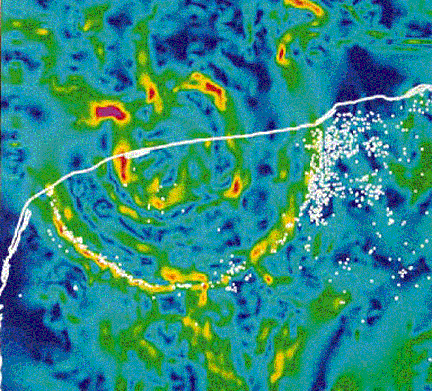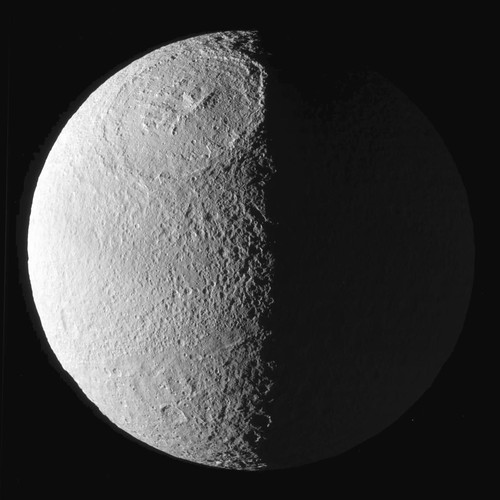Page 1 of 1
Mercury - Icy Planet? (APOD 08 Oct 2008)
Posted: Wed Oct 08, 2008 2:46 pm
by emc
http://apod.nasa.gov/apod/ap081008.html

The thing that is most striking for me regarding the Messenger mission is the incredible amount of detail that is available on the web. The amount of information is amazing and the
NASA Messenger website is way cool. 8)
Mercury may be
shrinking and there may be
ice on the surface.
Posted: Wed Oct 08, 2008 3:31 pm
by Dr. Skeptic
Mercury is the size of Mars (1/3 Earths gravity) but has nearly the same mass as the Earth. Most of the lighter elements of the solid surface have evaporated leaving Mercury floating around the Sun like a big heavy chunk of Fe.
Posted: Wed Oct 08, 2008 5:14 pm
by BMAONE23
Planet Radius(k) Mass (kg)
Mercury......2439.........3.30e23
Mars...........3397.........6.42e23
Earth
Moon..........1738.........7.35e22
Jupiter
Ganymede..2631.........1.48e23
Callisto.......2400.........1.08e23
Io...............1815.........8.94e22
Europa........1569.........4.80e22
Saturn
Titan...........2575.........1.35e23
Uranus
Titania..........789.........3.49e21
Neptune
Triton..........1350.........2.14e22
Pluto...........1160.........1.31e22
Some planetary size facts
Posted: Wed Oct 08, 2008 5:54 pm
by emc
speaking of sizes... wait a few seconds for the slide show to start...

Posted: Wed Oct 08, 2008 6:24 pm
by neufer
BMAONE23 wrote:Planet Radius(k) Mass (kg)
Mercury......2439.........3.30e23
Mars...........3397.........6.42e23
Earth
Moon..........1738.........7.35e22
Jupiter
Ganymede..2631.........1.48e23
Callisto.......2400.........1.08e23
Io...............1815.........8.94e22
Europa........1569.........4.80e22
Saturn
Titan...........2575.........1.35e23
Uranus
Titania..........789.........3.49e21
Neptune
Triton..........1350.........2.14e22
Pluto...........1160.........1.31e22
Some planetary size facts
Code: Select all
Ordered according to Mass:
Planet........Radius(k)... Mass (kg)
---------------------------------------
Mars............3397.........64.2e22
Mercury.........2439.........33.0e22
Ganymede........2631.........14.8e22
Titan...........2575.........13.5e23
Callisto........2400.........10.8e22
Io..............1815.........8.94e22
Moon............1738.........7.35e22
Europa..........1569.........4.80e22
Triton..........1350.........2.14e22
Eris............1300.........1.67e22
Pluto...........1160.........1.31e22
Lines - Canyong - Whatever
Posted: Wed Oct 08, 2008 8:04 pm
by Sputnick
I suspect from the many lines running (radiating? Is that the correct word?) from the poles that when closer photos come in we are going to have a debate which repeats the Martian Phoboesn debate - geyers .. steam vents - meteor strikes - canals carrying water - etc.. (Oops - or are they running from the poles?)
Vivaldi & other double-ring crater basins
Posted: Thu Oct 09, 2008 2:31 am
by neufer
------------------------------
Mercury : Vivaldi
http://messenger.jhuapl.edu/gallery/sci ... age_id=219
....................................

<<Numerous double-ringed craters may be seen on mercury. The crater Bach appears in the south polar regions of the planet, along with several others. The double-ring structures are not as prominent on the better-known near side of the Moon, but quite a few may be found on the farside as well as polar regions. It seems plausible that this particular structure was obscured or obliterated by the extensive flooding on the lunar near side.>>
http://www.astro.lsa.umich.edu/~cowley/intro2.html
Moon : Mare Orientale

Craters on the Moon pass through a sequence of typical shapes that depends approximately on their sizes (diameters, D):
* D < 20 km: craters are basically bowl shaped. This is true of both lunar and terrestrial explosion craters.
* 20 < D < 100 km: craters show central peaks.
* 100 < D < 350 km: double-ring structures.
* D > 400 km: multi-ring basins.
------------------------------
Chicxulub

 http://www.lpi.usra.edu/science/kring/e ... _hires.jpg
http://www.lpi.usra.edu/science/kring/e ... _hires.jpg
--------------------------------------------
Impact craters on Venus
http://www.athenapub.com/venus1.htm
 http://astrogeology.usgs.gov/Projects/V ... rtype.html
http://astrogeology.usgs.gov/Projects/V ... rtype.html
--------------------------------------------
Tethys : Odysseus

-----------------------------------








